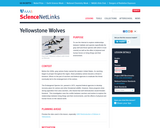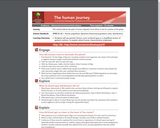
In this unit, students investigate how wind turbines and other forms of energy can affect wildlife.
- Subject:
- Biology
- Science
- Material Type:
- Unit of Study
- Provider:
- KidWind Project
- Author:
- KidWind Project
- Date Added:
- 02/26/2019

In this unit, students investigate how wind turbines and other forms of energy can affect wildlife.

Students investigate the interconnectedness of the ocean and Earth's physical and human systems through videos, discussions, writing, and mapping. They make personal connections to their own lives and are introduced to the concept of Marine Protected Areas (MPAs).

Students explore the connection between an herbicide used to kill weeds and the health of some populations of the frogs.

In this lesson, students use Internet resources to explore relationships between habitats and species as well as the effect of physical and human forces on living things and their environment.

This is an encyclopedia entry for "biosphere." The biosphere is made up of the parts of Earth where life exists. The biosphere extends from the deepest root systems of trees, to the dark environment of ocean trenches, to lush rain forests and high mountaintops. Text for this entry is appropriate for the middle and high school grade levels.

This is an encyclopedia entry for the term "ecosystem." An ecosystem is a geographic area where plants, animals, and other organisms, as well as weather and landscape, work together to form a bubble of life. Text for this entry is appropriate for the middle and high school grade levels.

This activity follows the path of human migration from Africa to the far reaches of the globe.

This is an encyclopedia entry for "keystone species," a plant or animal that plays a unique and crucial role in the way an ecosystem functions. Text for this entry is appropriate for the middle and high school grade levels.

This is an encyclopedia entry for the term "marine sanctuary." A marine sanctuary is a general type of marine protected area (MPA). The Flower Garden Banks National Marine Sanctuary and the Pelagos Sanctuary for Mediterranean Marine Animals are featured. Text for this entry is appropriate for the middle and high school levels.

This encyclopedia entry is for the term "tide." The regular rise and fall of the ocean?s waters are known as tides. Along coasts, the water slowly rises up over the shore and then slowly falls back again. Text for this entry is appropriate for the middle and high school grade levels.